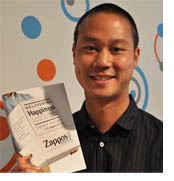The thing about Zappos is that it really might be a model for a new way to build and run a business.

Okay, now that seems like a stretch at first glance for an on-line etailer who's major claim to fame is that they sell a ton of shoes. But if you read the Zappos CEO's new book, Delivering Happiness, you may come to believe that Tony Hsieh (pronounced: Shay) is really on to something.
"It's about giving employees permission and encouraging them to just be themselves," says Hsieh. Seem a bit far-fetched? Read on, and see what you think.
It all began with worms, before shoes.
Are entrepreneurs born or made? In Tony's case the urge started young. "I think that's one of the things I've noticed in a lot of other entrepreneurs is they all have usually done all sorts of crazy things, and just tried a lot of things especially at a pretty young age. Growing up, whether it was garage sales, lemonade stands, and yeah, the idea of selling earthworms and making lots of money from that was one of my childhood dreams."
While earthworms didn't work out, a teenage button-making business turned a profit, and Hsieh was hooked on building businesses.
"I think entrepreneurs view the failures as getting one step closer to the success. As opposed to oh, like I'm a failure."
After a few attempts, and a big win at LinkExchange, Tony was looking for his next thing. "I used to wear one pair of shoes for two years," says Hsieh. But then he saw the future of feet. "The paper mail-order shoe catalogs back in '99 were 5% of the $40 billion-dollar market, so 2 billion dollars. So in our mind, at the very least, the Web was going to surpass 2 billion dollars."
Today, of course, Zappos is way more than shoes. "Without being super fashion focused, we know that many of our best sellers are brands that even you and I know, but we definitely have the long-tail customer as well."
For the book, Delivering Happiness is a chronicle of the journey, and of Tony's early life as an entrepreneur.
In many ways, it's two books for the price of one.
It's a funny, wry, honest autobiography of a striving Asian American who's got the drive and ambition of his family deeply ingrained, and at the same time the irreverence of a slacker college student who's looking to create a "vibe" that makes the people around him feel like they're part of something special.
Tony's childhood is a textbook entrepreneur's trial and error. His first job, raising and selling worms, isn't a huge success. But then, from the back page of Boys' Life magazine, Tony tries first greeting cards, and then selling custom buttons. The button business takes off, becoming something of a family legacy handed down from brother to brother, and making hundreds of dollars a month as the mail-order business grew.
Early on the postman was Tony's friend. And in many ways the success at Zappos today can be tracked back to that feeling that Tony had as a child -- of wanting something magical to come in the mail, and enjoying the feeling of getting that mail-order burst of pleasure when the mailman delivers his anticipated gifts.
Of course, Tony isn't the only entrepreneur who started out of the back of Boys' Life, or who dabbled in magic as a way to both understand human emotions and put on a show. (Yes, I had doves, and he didn't -- but the impulse is the same).
But what you begin to understand as you pore over his immensely readable book is that Zappos today is rooted in Tony's youthful pleasures and passions. In fact, Tony found a lot of inspiration in the rave scene, throwing massive parties and embracing the music, lights, and smoke that turned many individuals into a communal, and connected gathering. It's kind of hard to think of Tony as a raver, but then again, what does a "raver" look like?
Says Hsieh "It's actually really funny. I've had people come up to me and say oh, I used to go to raves. I would never have guessed that about them. So I don't know what a raver looks like 10 years later in general."
But today Zappos has an employee culture that seems very much of one mind, focused on customer service and not in some sort of cookie-cutter corporate way. Zappos really cares that you're happy, and it's baked into their beliefs, their customer interaction, and even the way they hire.
"When we hire people we do two sets of interviews. The hiring manager and his or her team will do the standard fit within the team, relevant experience, technical ability and so on. But then our HR department does a second set of interviews purely for culture fit."
"We've formalized the definition of our culture into 10 core values. Basically what we're looking for are peoples whose personal values match our corporate values. They're just naturally living the brand. Wherever they are whether they're in the office or off the clock."
The Zappos Core Values are:
- Deliver Wow Through Service
- Embrace and Drive Change
- Create Fun and a Little Weirdness
- Be Adventurous, Creative and Open-Minded
- Pursue Growth and Learning
- Build Open and Honest Relationships with Communication
- Build a Positive Team and Family Spirit
- Do More with Less
- Be Passionate and Determined
- Be Humble
And the thing that Zappos figured out, and continues to deliver on, is the idea that people who don't fit the company culture are better off being paid to leave.
"Everyone that's hired, it doesn't matter what position--you can be an accountant, lawyer, software developer--goes through the exact same training as our call center reps. It's a four-week training program and then they're actually on the phone for two weeks taking calls from customers. At the end of that first week of training we make an offer to the entire class that we'll pay you for the time you've already spent training plus a bonus of $2,000 to quit and leave the company right now."
Paying new hires to leave may seem counter-intuitive, but for Tony, it makes simple sense. "Really, the goal of that originally was to weed out the people that are just there for a paycheck."
In the end, the culture is about more than money. "It's not me saying to our employees, this is where our culture is. It's more about giving employees permission and encouraging them to just be themselves.
For Tony, building Zappos hasn't been easy. In fact, the story has more twists and turns than you might imagine as in the early days when Sequoia Capital was ready to throw in the towel, "I think they just assumed the company would either go out of business or possibly get funding from someone else. But this was back in what 2002. So the dot-com crash had just happened, Pets.com went out of business, and e-commerce in general were not looked favorably upon. So I don't think it was Sequoia. I think VCs in general at the time weren't making investments."
Tony had to sell his prized party loft (at a significant loss) just to make payroll, but they made it round the bend. "Our customers didn't know that we were struggling with cash flow and so on. So, customers kept coming. Our revenues were going up, and so we knew that there was definitely a potential business here. So, it was never a question of whether the idea would work. It was just whether we could get over that cash flow hump."
In some ways the trends happening today in social networking seem like they were designed for the uber-transparent CEO. Twitter, for example, was a no-brainer for Zappos. But other trends, like virtual offices, don't work for Tony. He says a community needs proximity, and for him Vegas was the right place to locate and build Zappos. Zappos isn't virtual, it's physical. "We really wanted to build the company around culture, company culture being the number one priority. And it's much easier to build a culture when it's actually in person versus remotely by email."
And while Zappos remains the company that will pay you to leave, Tony reveals that they haven't had to write a check like that in almost a year. Zappos, it seems, is a place folks aren't in a hurry leave once they get in the door. Tony says it's about happiness.
"So many people when they go to the office, they leave a little bit of themselves at home, or a lot of themselves at home. And they have to put on this different persona in the office, especially in corporate environments. And our whole...there's a lot of talk about work life separation or balance and so on, whereas our whole thing is about work life integration. Its just life."
As you read Delivering Happiness, it's clear that Hsieh is talking about customer happiness, but also employee happiness, and even his happiness. He says the goals of happiness aren't mutually exclusive.
"There's a lot of talk about work life separation or balance and so on, our whole thing is about work life integration. Its just life. And so the ideal would be if you can be the same person at home as you are in the office, and vice versa. And when people actually feel comfortable being themselves, so much creativity comes out of that."
So, if you believe Hsieh, there really is a change in the wind. A change in the way companies think, and act, and those that understand that will survive and thrive.
"I think we're just at the beginning where companies are becoming more and more transparent whether they like it or not. People are becoming...just because the information is everywhere and it's pretty hard to control now. So I think moving forward it's going to be only the authentic companies or people can win because everyone else will eventually be outed."
Can it be that happiness is profitable?
The book is titled Delivering Happiness and the subtitle is A Path to Profits, Passion and Purpose. Tony Hsieh says in the book that research found that the best companies in terms of long-term financial performance are ones that are able to combine profits, passion and purpose.
If that's true, then we're standing at the edge of a new Happiness Culture, and it all began with selling shoes online.
"There's three types of happiness and really happiness is about being able to combine pleasure, passion, and purpose in one's personal life. I think it's helpful and useful to actually think about all three in terms of how you can make customers happier, employees happier, and ultimately, investors happier."
Watch all the Tony Hsieh interview videos on Curation Nation.
Follow author Steve Rosenbaum on Twitter @Magnify
